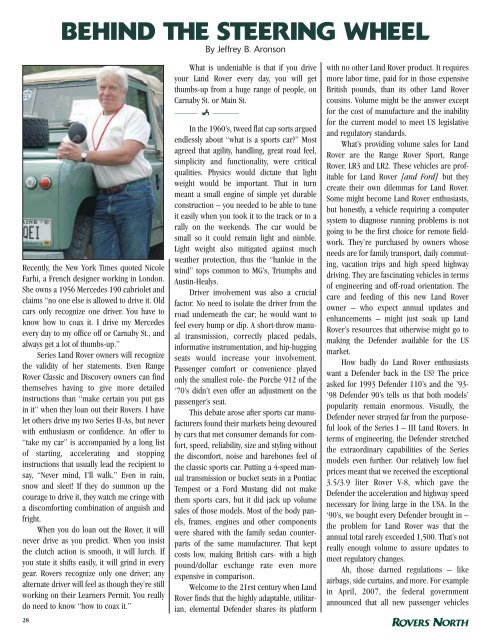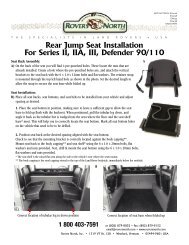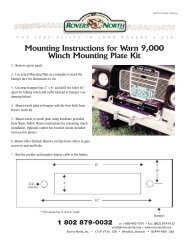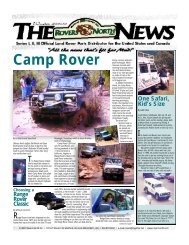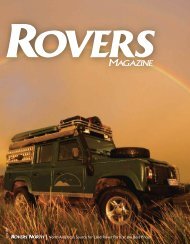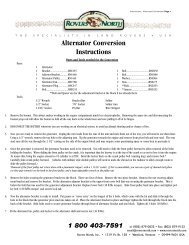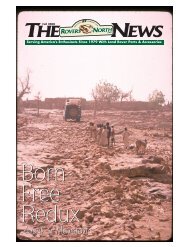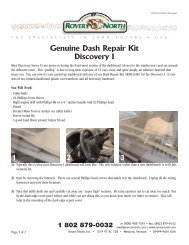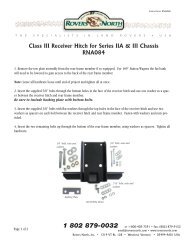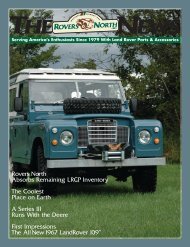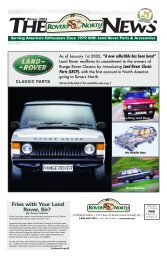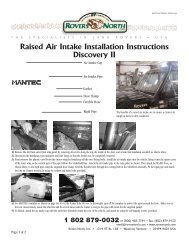Range Rover Classic - Rackspace Hosting
Range Rover Classic - Rackspace Hosting
Range Rover Classic - Rackspace Hosting
Create successful ePaper yourself
Turn your PDF publications into a flip-book with our unique Google optimized e-Paper software.
Recently, the New York Times quoted Nicole<br />
Farhi, a French designer working in London.<br />
She owns a 1956 Mercedes 190 cabriolet and<br />
claims “no one else is allowed to drive it. Old<br />
cars only recognize one driver. You have to<br />
know how to coax it. I drive my Mercedes<br />
every day to my office off or Carnaby St., and<br />
always get a lot of thumbs-up.”<br />
Series Land <strong>Rover</strong> owners will recognize<br />
the validity of her statements. Even <strong>Range</strong><br />
<strong>Rover</strong> <strong>Classic</strong> and Discovery owners can find<br />
themselves having to give more detailed<br />
instructions than “make certain you put gas<br />
in it” when they loan out their <strong>Rover</strong>s. I have<br />
let others drive my two Series II-As, but never<br />
with enthusiasm or confidence. An offer to<br />
“take my car” is accompanied by a long list<br />
of starting, accelerating and stopping<br />
instructions that usually lead the recipient to<br />
say, “Never mind, I’ll walk.” Even in rain,<br />
snow and sleet! If they do summon up the<br />
courage to drive it, they watch me cringe with<br />
a discomforting combination of anguish and<br />
fright.<br />
When you do loan out the <strong>Rover</strong>, it will<br />
never drive as you predict. When you insist<br />
the clutch action is smooth, it will lurch. If<br />
you state it shifts easily, it will grind in every<br />
gear. <strong>Rover</strong>s recognize only one driver; any<br />
alternate driver will feel as though they’re still<br />
working on their Learners Permit. You really<br />
do need to know “how to coax it.”<br />
28<br />
BEHIND THESTEERING WHEEL<br />
By Jeffrey B. Aronson<br />
What is undeniable is that if you drive<br />
your Land <strong>Rover</strong> every day, you will get<br />
thumbs-up from a huge range of people, on<br />
Carnaby St. or Main St.<br />
_______ ________<br />
In the 1960’s, tweed flat cap sorts argued<br />
endlessly about “what is a sports car” Most<br />
agreed that agility, handling, great road feel,<br />
simplicity and functionality, were critical<br />
qualities. Physics would dictate that light<br />
weight would be important. That in turn<br />
meant a small engine of simple yet durable<br />
construction – you needed to be able to tune<br />
it easily when you took it to the track or to a<br />
rally on the weekends. The car would be<br />
small so it could remain light and nimble.<br />
Light weight also mitigated against much<br />
weather protection, thus the “hankie in the<br />
wind” tops common to MG’s, Triumphs and<br />
Austin-Healys.<br />
Driver involvement was also a crucial<br />
factor. No need to isolate the driver from the<br />
road underneath the car; he would want to<br />
feel every bump or dip. A short-throw manual<br />
transmission, correctly placed pedals,<br />
informative instrumentation, and hip-hugging<br />
seats would increase your involvement.<br />
Passenger comfort or convenience played<br />
only the smallest role- the Porche 912 of the<br />
‘70’s didn’t even offer an adjustment on the<br />
passenger’s seat.<br />
This debate arose after sports car manufacturers<br />
found their markets being devoured<br />
by cars that met consumer demands for comfort,<br />
speed, reliability, size and styling without<br />
the discomfort, noise and barebones feel of<br />
the classic sports car. Putting a 4-speed manual<br />
transmission or bucket seats in a Pontiac<br />
Tempest or a Ford Mustang did not make<br />
them sports cars, but it did jack up volume<br />
sales of those models. Most of the body panels,<br />
frames, engines and other components<br />
were shared with the family sedan counterparts<br />
of the same manufacturer. That kept<br />
costs low, making British cars- with a high<br />
pound/dollar exchange rate even more<br />
expensive in comparison.<br />
Welcome to the 21rst century when Land<br />
<strong>Rover</strong> finds that the highly adaptable, utilitarian,<br />
elemental Defender shares its platform<br />
with no other Land <strong>Rover</strong> product. It requires<br />
more labor time, paid for in those expensive<br />
British pounds, than its other Land <strong>Rover</strong><br />
cousins. Volume might be the answer except<br />
for the cost of manufacture and the inability<br />
for the current model to meet US legislative<br />
and regulatory standards.<br />
What’s providing volume sales for Land<br />
<strong>Rover</strong> are the <strong>Range</strong> <strong>Rover</strong> Sport, <strong>Range</strong><br />
<strong>Rover</strong>, LR3 and LR2. These vehicles are profitable<br />
for Land <strong>Rover</strong> [and Ford] but they<br />
create their own dilemmas for Land <strong>Rover</strong>.<br />
Some might become Land <strong>Rover</strong> enthusiasts,<br />
but honestly, a vehicle requiring a computer<br />
system to diagnose running problems is not<br />
going to be the first choice for remote fieldwork.<br />
They’re purchased by owners whose<br />
needs are for family transport, daily commuting,<br />
vacation trips and high speed highway<br />
driving. They are fascinating vehicles in terms<br />
of engineering and off-road orientation. The<br />
care and feeding of this new Land <strong>Rover</strong><br />
owner – who expect annual updates and<br />
enhancements – might just soak up Land<br />
<strong>Rover</strong>’s resources that otherwise might go to<br />
making the Defender available for the US<br />
market.<br />
How badly do Land <strong>Rover</strong> enthusiasts<br />
want a Defender back in the US The price<br />
asked for 1993 Defender 110’s and the ’93-<br />
’98 Defender 90’s tells us that both models’<br />
popularity remain enormous. Visually, the<br />
Defender never strayed far from the purposeful<br />
look of the Series I – III Land <strong>Rover</strong>s. In<br />
terms of engineering, the Defender stretched<br />
the extraordinary capabilities of the Series<br />
models even further. Our relatively low fuel<br />
prices meant that we received the exceptional<br />
3.5/3.9 liter <strong>Rover</strong> V-8, which gave the<br />
Defender the acceleration and highway speed<br />
necessary for living large in the USA. In the<br />
‘90’s, we bought every Defender brought in –<br />
the problem for Land <strong>Rover</strong> was that the<br />
annual total rarely exceeded 1,500. That’s not<br />
really enough volume to assure updates to<br />
meet regulatory changes.<br />
Ah, those darned regulations – like<br />
airbags, side curtains, and more. For example<br />
in April, 2007, the federal government<br />
announced that all new passenger vehicles


